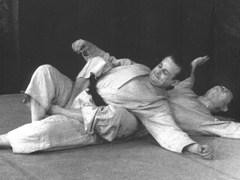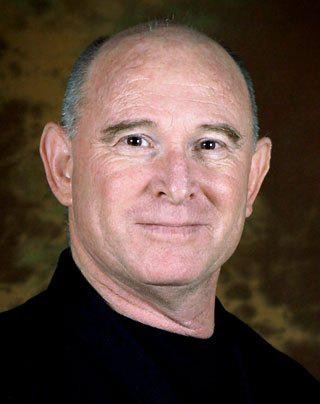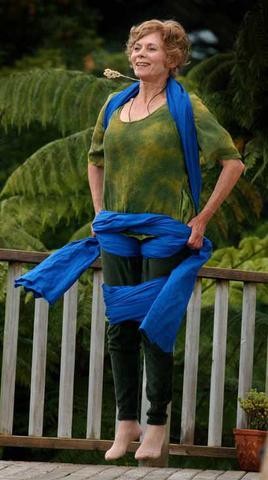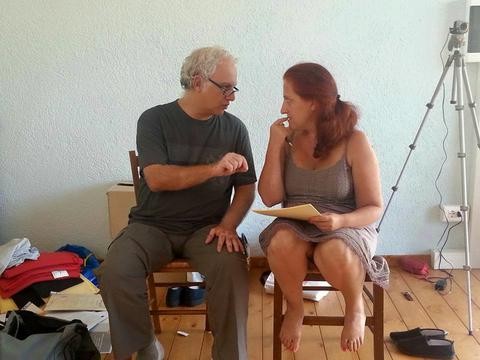The Martial Arts Roots of the Feldenkrais Method
Article by Raffaele Rambaldi
Moshe Feldenkrais has often been called a modern ‘Renaissance Man’ because of the many sides of his personal development and his vast range of interests. Physicist, engineer, the first Judo black belt in Europe; through his fascinating journey of personal discovery which began with the search for a means of regaining the use of his seriously damaged knees, he ended up developing a brilliant method of learning and self-development through movement with its innumerable possibilities and applications.
To really get into the Feldenkrais Method it is essential to try to tune into the thought processes of its founder, with his wonderful ability to take abstract ideas and transfer them to the level of concrete actions and personal experience, re-tracing the steps and the mental processes which he followed in the evolution of his thinking.

Moshe Feldenkrais practising judo
We will soon have the chance to do this. We actually have the privilege of hosting in Italy Shihan Moti Nativ, an internationally recognised expert in martial arts and a brilliant exponent of the Feldenkrais Method who will lead the seminar ‘Warrior’s Awareness : the Synergy of Martial Arts and the Feldenkrais Method’.
Over two days Moti will lead us to rediscover the deep martial arts roots of the Method, reconstructing in retrospect the route which Feldenkrais took which began with a personal quest in ‘street fighting’ self-defence, and led him first to become a Master of Martial Arts and then to develop the brilliant Method which takes his name. This is really an exceptional opportunity for anyone who wants to deepen their experience of the Feldenkrais Method, martial arts and the improvement of movement in general through a work of awareness.
But what is Feldenkrais’ martial arts history?[1]

As I have said, he was the first Judo black belt in Europe. But Moshe’s ‘martial arts’ journey began much earlier, with his activity in the Jewish defence forces (1920-1930). In fact when he arrived in Palestine under the British protectorate, long before Israel existed as an independent state, the young Feldenkrais came into contact with Haganah, a secret organisation which had as its primary aim the protection of Jewish settlements. At that time skirmishes between Jews and Arabs were very frequent and the British had only limited success in preventing them. This was the reason for the idea of giving members of the organisation training in self defence and Ju-Jitsu.
But the results were not at all good; it turned out that in real encounters the people who tried to run away got off much better than those who stayed to fight with their Ju-Jitsu and often tragically had the worst of it. The few months of lessons proved to be insufficient, and the type of training proposed inefficient or positively counterproductive in a real life situation.
Based on these experiences, at the age of 27 Moshe wrote his first book, Ju-Jitsu and Self-Defense (1931), the first self-defence book in Hebrew. Many people hold that the genesis of Israeli martial arts (Krav Maga, Kapap, etc) may be traced back to Moshe Feldenkrais as the forerunner of the exploration of the psychological aspects of combat situations and the principles of learning, and the founder of the instinctive techniques present in the methods taught by Haganah. On moving to France in the ‘30s, Moshe Feldenkrais founded the Ju-Jitsu Club of France.
Kano, in fact, who had gone to France to demonstrate his Judo, had Feldenkrais’ book in his hands and wanted to get to know its author, intrigued by the pictures of the technique founded by Feldenkrais. During the meeting Moshe showed his original technique for defence against a knife attack. Moshe was fascinated by Kano’s ‘mind over body’ concept as a means of self development. Jigoro Kano, struck by Feldenkrais’ lively intelligence, decided to gamble on trusting him for developing and diffusing his Judo in the West. And so it was that Moshe Feldenkrais became the first Judo black belt in Europe.
Moshe thought of Judo (and probably of martial arts in the broadest sense) as an aim, the ultimate effectiveness in real time and in the reality of the gravitational field with an unpredictable partner. [2]. His researches would probably have continued in this direction if he had not had the serious problem of the injury to his knee.
In the process of finding a way to regain the use of his damaged knees he began to do 360° research into human movement putting together his personal knowledge of physique and martial arts with disciplines such as anatomy, anthropology, biochemistry, theories of learning, neurophysiology and psychology. His conclusions not only helped him to overcome the problem with his knee but also went to improve the general quality of movement both of Feldenkrais himself and of the friends with whom he had shared his researches.
In this way he developed a method which has shown itself applicable not only to illness and discomfort but also to the general way in which we human beings can live our lives more fully. When the body functions in an integrated way many of the pains or discomforts disappear or at least our capacity to cure them increases. It is an approach which involves the relationship between mind and body and which has more to do with working on the complex quality of movement than with trying to treat a localised problem in isolation. All this goes well beyond treating problems or pains. It is to do with learning to use one’s body in a better and more efficient way. This is why it is so widespread among athletes, dancers, artists and martial arts practitioners at a high level.
Improving the quality of movement, following the most natural methods of learning of our nervous system, Feldenkrais’ work permits the creation of force, speed and power without effort, with an extremely highly developed type of training.
For instance, if we look at a grand master of martial arts, a dancer or an athlete, the thing we immediately notice is that each of them moves with precision, ease, lightness and grace despite being at the same time strong and incisive. Most students are not capable of doing this, and almost all make use of effort. Seeing an expert, in fact, they try to imitate his or her movements, but imitating the external movement does not produce the skill. The Feldenkrais method deals with the essence of movement. Through exploring and listening to the way in which we move ourselves and act we can distinguish and filter what is good for us from what is not. And we can improve whatever technique or movement we are interested in, learning at incredible ease and speed, making stable, lasting and significant changes in our lives in both the short term and the long term.
Moshe called this type of bodily experience Awareness Through Movement (ATM) which is a key concept in the Feldenkrais Method.

Listening to Moti Nativ’s words reminded me of an interview with Moshe Feldenkrais broadcast in the ’70s which I saw during the years of my training as a teacher [4]. Moshe and the young interviewer were sitting opposite each other, but in a totally different position. The interviewer noticed this difference; in fact, while his posture was slouched and ‘slumped’’, Feldenkrais was aligned but not stiff; well centred. Despite his age he resembled a lion. Invited to comment on this difference, Feldenkrais said something along the lines of ‘From how you are sitting you must suffer from back pain, or neck pain, and probably also from pain in the knees’. The interviewer went pale…Feldenkrais had evidently described the situation well. But Moshe did not stop there: ‘if a coyote came into this room, I would probably manage to escape while you, sitting like that, would not even have time to stand up!’ Marvellous! In a few words he had shown his two spiritual sides, that of the ‘healer’ and that of the ‘warrior’. His criterion for good health overlapped the martial arts aim of being well organised for action and survival, ready to deal with unforeseen changes in an unpredictable environment. All this is something which goes beyond alignment and optimal biomechanical functionality. It implies a sense of awareness, presence, and ability for instinctive response. Being like a tiger which stares into your eyes, completely and utterly ‘here and now’.
Martial arts, from a certain level onwards, become a training programme for learning to ‘feel’ and to act. A warrior does not chatter about awareness, he puts it into practice. And Feldenkrais carried all this over into his system which is effectively a training programme for learning to feel, recognise possibilities and options, choose, put into practice and check what works best for us. ‘Awareness heals’ as Steven Shafarman says in the title of his excellent book [5].
I want to stress that presence, awareness, attention, the ability to remain lucid in conditions of stress or emergency, to feel secure in your own body, in your own movement, in your own ability to respond naturally to whatever happens, are not just essential for a martial arts practitioner or a warrior but are infinitely valuable every day in every situation of our lives.
Now, in our time, the aim is to develop ourselves as human beings in a healthy way, at every level, both spiritually and physically. The two things go together. Moshe developed his own method as a work of learning and awareness. When you are aware you can learn something for your whole life and make yourself open to change to the point of being able to say: ok, this is not helpful for me, I can change it for something else’.

On this subject I remember how one afternoon, in the second year of my training as a Feldenkrais teacher, Ruthy Alon told us about one of her experiences going back to the early ‘70s when for five weeks she stayed in Hawaii to teach Feldenkrais. On the island there was a very good Dojo where Aikido was practised so she got into the habit of going there every morning very keen to practice. One day she wanted to show the teacher the things we do in Feldenkrais so she stretched out on the ground and began to make a few ATM movements. But to her surprise the teacher said to her ‘No, no, no! You have no energy! You have no ki! Whereas your master has ki!’ [6].
At the time Ruthy was not much more than forty years old and was already one of the most advanced Feldenkrais teachers, at the forefront of the exploration of the most advanced nuances and applications of the movement. These words drove her for years to continue her research towards that subtle inner attitude which perhaps has to do with what the Japanese call ‘ki’ and which has certainly come together in the creation of her Bones for Life, the programme for postural reorganisation and strengthening of bones through movement based on the learning strategies developed by Feldenkrais. And today, Ruthy seems much stronger, more centred and more powerful than in the past, despite the fact that forty years have passed since her meeting with that Aikido master. If we carefully examine the Bones for Life programme we notice that it goes way beyond strengthening bones. Rather, looking at it another way, this benefit seems to become one unusual side-effect of a still more ambitious task…
The Aikido master had seen truly: Feldenkrais had ‘ki’, that mysterious word which fascinates or disconcerts us Westerners but which is so familiar in the culture of the Far East. In fact Feldenkrais, with his profound experience in oriental martial arts and his lessons with the great Japanese masters, knew and applied in the teaching and practice of Judo the concepts and the principles of ‘ki’ and of seika-tanden breathing. But such concepts which are so culturally present and familiar in Japan or in China were difficult to transfer effectively to the West. So he chose to put forward these ideas in terms of movement, at the level of muscles and nerves, changes and improvements in the neuromuscular organisation. It may be that this way of putting it does not please people who are passionate about mysterious things like ‘ki’ and ‘chi’. But it worked - and how!- and in this way, before dedicating himself completely to research and the development of his method, he trained several students (some quite old) who were eventually to become among the best in the world and who in their turn ‘had ki’. Incidentally, Jigoro Kano himself and Koizumi (author of the preface of Feldenkrais’ book Higher Judo) have always agreed with Feldenkrais on the choice of a formulation in phrases whose sense is more easily understandable by people who grew up in the culture of the West.
The martial spirit of Moshe Feldenkrais is deeply incorporated into his system. And significantly present also is the study which he made on the ‘inner structure of martial arts’, this type of internal organisation which allows the old masters, even at an advanced age, to overpower students who are younger and physically much stronger than they are. For this reason and for many others, the rediscovery of the martial-arts roots of the Feldenkrais method is an extremely valuable thing for everyone, at whatever level. Obviously it is in order to draw still more benefits from the practice of the Feldenkrais Method. But it is too for anyone who practices martial arts or any other movement-based activity from dance to sport, or who simply wants to feel healthy and fit.
Feldenkrais’ ultimate aim related to how we can become more mature as human beings. And movement is the ideal tool with which to explore this process...
Note
[1] For the martial arts history of Moshe Feldenkrais see:
- Moshe Feldenkrais, Hadaka-Jime – Practical Unarmed Combat, foreword by Moti Nativ, Genesis Publishing (USA), 2009
- Moshe Feldenkrais, The extraordinary story of how Moshe Feldenkrais came to study Judo – interview with Dennis Leri, in Embodied wisdom – the collected papers of Moshe Feldenkrais edited by Elizabeth Beringer, North Atlantic Books and Somatics Resources (USA), 2010
- Moshe Feldenkrais, Higher judo, Somatic Resources (USA), 2010
- Moti Nativ, Martial Arts – Roots of the Feldenkrais Method – Improve survival abilities, http://www.bujinkan-israel.co.il/46250/Improve-Survival-Abilities--Introduction
[2] See the interview with Ruthy Alon Un Incontro con Ruthy Alon
[3] See on Youtube the interview with Moti Nativ in Hebrew with English subtitles http://www.youtube.com/watch?v=qai7sdixZJA
[4] Moshe Feldenkrais, Medicine Man: interview with Moshe Feldenkrais, available through FeldenkraisResources.
[5] Steven Shafarman, Awareness heals: the Feldenkrais Method for Dynamic Health; published in Italy as Conoscersi è guarire – le 6 lezioni pratiche del Metodo Feldenkrais, Astrolabio-Ubaldini, 1997
[6] Ruthy Alon, Feldenkrais Method Training, Florence 2, second year, 18 July 1998.
